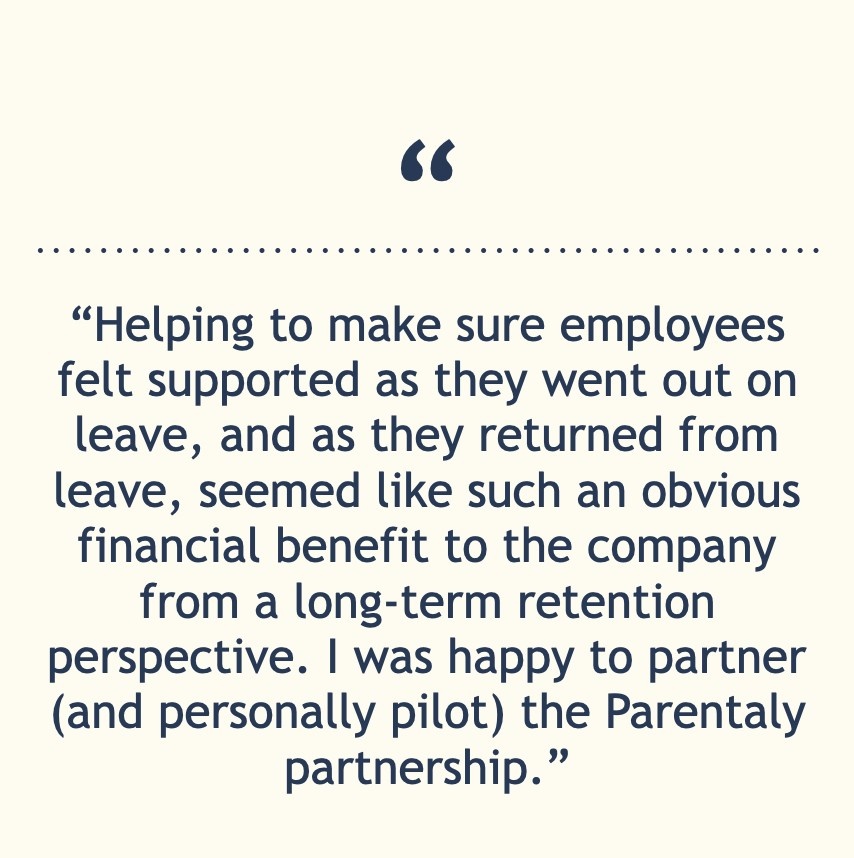Erin's story:
A mom starts her own graphic design business to call the shots for herself professionally and personally
Erin Steven, a design director with nearly two decades of experience, started her own business when she was two years into motherhood after she and her partner adopted their son Graham.
Erin and her partner had six weeks from their match date until their son’s birth, which gave them a little more time to prepare than they expected.
And while taking parental leave was a non-negotiable for them both, the most challenging part was figuring out how to budget their finances to include roughly a fifth of a year of no income.
Unfortunately her partner did not have a paid parental leave policy, so she was only able to take 10 weeks of unpaid FMLA leave - while Erin, who was working for herself during Graham’s adoption, took some time away with no compensation and worked very limited hours.
But still, parenthood helped Erin work smarter. While she can multi-task almost anything, doing so for work commitments and spending time with her son was not an option. This realization allowed her to completely separate work time from family time once she got back to work.
As a business owner, it means she sometimes focuses on work during off-business hours - but uses the ‘schedule send’ email tool to ensure clients don’t expect constant communication at all hours of the night.
Becoming a parent also helped her respect her personal boundaries – from being able to say no to tasks she can’t take on to better managing meetings better to protect her (and others’) time.
When asked the best way that companies can support adoptive parents, Erin strongly encourages employers to treat adoptive parents with the same policies as biological parents:
“We may not be recovering from birth, but we’re still not getting any sleep, still dealing with a completely new dynamic in our home and still caring for a child 24/7.
Adoptive babies have the same needs as biological babies. They still need to be fed constantly, still go through 12 diapers a day, still need to be burped, held, talked to and smothered with love.”
Read Erin’s full Q&A below to learn how she sets boundaries both at work and home to the benefit of her family, her clients and herself
Can you share a brief professional summary that provides context about your work situation immediately preceding having children through today?
“I am a design director with nearly two decades of experience. I started my own studio in an effort to work with clients that mean something to me, that make a positive impact on the world and that allow me to feel comfortable bringing my whole self to my job. I started Curious 7 when my son was two-years-old because I wanted to be able to call the shots for myself professionally and personally.”
What was the most challenging part of taking parental leave and how did you address or overcome it?
“Budgeting our finances to include roughly a fifth of a year of no income on top of new medical and adoption expenses (which are no joke).”
What mistakes did you make? Are there things you wish you had done differently before, during or after your parental leave?
“I’m not really sure what we could have done differently. In addition to obligations any new parent has (nighttime feedings, doctor appointments, etc), we had additional obligations to our birth family that took time away from working and career development.”
If you had to name one thing (something you do, something you buy, something you have) that has had the greatest impact on your ability to manage working parenthood, what would it be?
“Getting work done in off-business hours after my child is asleep, but scheduling communications for normal working hours has been a game-changer.”
Many parents say that once they had children their “bar” became higher. They no longer tolerated wasteful work, unproductive meetings, etc. What else would you say changed as it relates to your career or work style once you had kids?
“Having a kid made me respect my own personal boundaries—being able to say no, not just for him/us, but for me. Honestly, ‘scheduled send’ on emails is one of my favorite tools. It allows me to work after my kid goes to bed, but appear to only be available during normal working hours.
I also refuse to schedule meetings that aren’t beneficial to all the involved parties. Useless meetings are infuriating. As a business owner, I get to decide when and how often to schedule most of my meetings. When I’m on vacation, I make it clear to clients that I will be unavailable and I make sure to be utterly unreachable so they take that seriously. Again, schedule send!”
What boundaries do you maintain as it relates to work/home? How have these boundaries shifted over time?
“I truly try to focus on one thing at a time rather than multitasking; this is non-negotiable. If I’m spending time with my son, I don’t allow work to interrupt it. If I am working, either his other parent needs to spend time with him or he must find something to do on his own. I’ve found that while I can multitask a lot of things, if any of it involves my kid, multi-tasking is not an option. Everyone gets frustrated.”
If you could give another parent [in a similar position as you] one piece of advice leading up to their parental leave, what would it be?
“Advocate for yourself, no matter how uncomfortable it is. You will want or need more time than you think. We all come in thinking we can handle it all, but the truth is, especially for a first-time parent, we have no idea what our kid will need, what we’ll need, and if we are partnered, what our partner will need.”
What is one professional achievement that you’re most proud of since becoming a parent and why?
“It’s less about what I do for a living and more that my son sees two parents making time for their talents as well as him. As a two-mom-crew, it’s important to us that he sees women coming from an equal place of decision-making and respect. The delineation of tasks in our home are based on our skill sets and not gender. His other mother and myself are both elite athletes, and we treat those activities as seriously as our professional careers. I am proud that he sees us both work hard to achieve goals, and how we deal with it when we don’t hit those goals.”
What was the biggest challenge that you faced while going through the adoption process while working?
“Things don’t move at all until they move very quickly. Trying to figure out when to tell a client/employer you’re in the process is a challenge in itself. A pregnancy has a fairly set timeline. Adoption may take years to start, but often, once you’re chosen, you have very little time to prepare.
In our case, we had a lot more time to prepare than the average adoptive parent. We had six weeks, while many have a few days—and sometimes, the baby has already been born. In that time, you end up telling your client/employer a) we started this process b) it’s happening NOW c) this is when I will need time (and it’s not two trimesters away).”
What is the best way that companies can support adoptive parents?
“Treat adoptive parents with the same policies as biological parents. We may not be recovering from a birth, but we’re still not getting any sleep, still dealing with a completely new dynamic in our home and still caring for a child 24/7. Adoptive babies have the same needs as biological babies. They still need to be fed constantly, still go through 12 diapers a day, still need to be burped, held, talked to and smothered with love.”
Want to be the first to know about new stories like this?
Subscribe to our newsletter to receive profiles of inspiring working parents
directly in your inbox each month.


